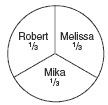This is a level 4 measurement activity from the Figure It Out theme series.
A PDF of the student activity is available.
Click on the image to enlarge it. Click again to close. Download PDF (589 KB)
express fractions of a circle in degrees
FIO, Levels 3-4, Theme: Moving House, Farewell Party, page 24
Scissors, crayons or felt-tip pens
Cardboard
A protractor
In this activity, students divide a circular cake into 3 equal parts and then 24 equal parts. To do this, they need to understand:
• that angle is the measure of turn
• that there are 360 degrees in one complete turn (that is, a circle)
• how to relate a fraction of a circle to a measurement in degrees
• how to use a protractor to measure angle in degrees.
One way of introducing the concept of angle is to ask how you might measure how far a door has been opened. Why not just use centimetres? Centimetres are a measure of length, and when you open a door, different parts of the door actually travel different lengths. The leading edge of the door travels much further than the edge by the hinge, which hardly moves at all. So angle is very different to length and needs a different system of measurement.
Why are there 360 degrees in a circle? The number is arbitrary (an alternative system is also occasionally used, gradians, in which a complete turn is divided into 400). Nevertheless, 360 is a good choice, and this could be discussed with the class. Because it is a multiple of a remarkably large set of numbers: 2, 3, 4, 5, 6, 8, 9, 10, 12, 15, 18, 20, 24, 30, 36, 40, 45, 60, 72, 90, 120, and 180 – 22 in all – it is possible to conveniently measure many angles without having to use fractions.
Students need practice at relating fractions of a circle to 360 degrees. It will help if they can see that the numbers on the above list of factors work in pairs: just as a circle can be divided into nine parts, each of 40 degrees, it can also be divided into 40 parts, each of 9 degrees.
Check that all the students know how to use a protractor before they begin this activity. A protractor is to angle what a ruler is to length. Given that protractors are normally made of clear plastic, it is easy to demonstrate their use to a class by laying them on an overhead projector and projecting the image onto a screen or wall. An alternative is to use a large-scale wooden or plastic protractor, sold as a teaching aid.
Question 4 requires the students to divide 360 degrees by 24. Ask them to demonstrate with their arms how big they think 15 degrees is. Learning to visualise the size of an angle is the key to avoiding foolish answers. The most common error when using a protractor (apart from inaccuracy resulting from carelessness) is to read off the supplement of the desired angle (for example, 100 degrees instead of 80 degrees). If they know what they are looking for, your students are unlikely
to fall into this trap.
Question 5 calls for some lateral thinking. A horizontal cut followed by 6 vertical cuts through the centre will divide the cake into 24 equal pieces. (Some people don’t like icing anyway!)
Answers to Activity
1. Each slice of cake should be 1/3 of the total size, as in the diagram:
2. a. 1/3
b. 2/3
3. a. 120°
b. 240°
4. a. 15°
b. Practical activity
5. a. 12
b. The cake can be divided using 7 cuts. First slice it horizontally, then use 6 vertical cuts to divide it into twelve 30º sectors. This will give 24 equal pieces.

